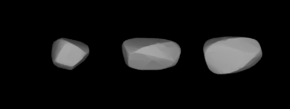Loading AI tools
Asteroid named in honor of Carl Sagan From Wikipedia, the free encyclopedia
2709 Sagan, provisional designation 1982 FH, is a stony Florian asteroid from the inner regions of the asteroid belt, approximately 6.7 kilometers in diameter. It was discovered on 21 March 1982, by American astronomer Edward Bowell at Lowell's Anderson Mesa Station near Flagstaff, Arizona, and named after astronomer and science popularizer Carl Sagan.[2][8]
 Lightcurve-based 3D-model of Sagan | |
| Discovery [1] | |
|---|---|
| Discovered by | E. Bowell |
| Discovery site | Anderson Mesa Stn. |
| Discovery date | 21 March 1982 |
| Designations | |
| (2709) Sagan | |
Named after | Carl Sagan (astronomer and science communicator) [2] |
| 1982 FH · 1951 WF1 1959 CC · 1959 EA1 1964 WT · 1982 FE2 | |
| main-belt · Flora [3] | |
| Orbital characteristics [1] | |
| Epoch 4 September 2017 (JD 2458000.5) | |
| Uncertainty parameter 0 | |
| Observation arc | 58.15 yr (21,239 days) |
| Aphelion | 2.3475 AU |
| Perihelion | 2.0428 AU |
| 2.1952 AU | |
| Eccentricity | 0.0694 |
| 3.25 yr (1,188 days) | |
| 319.11° | |
| 0° 18m 10.8s / day | |
| Inclination | 2.7318° |
| 241.13° | |
| 308.48° | |
| Physical characteristics | |
| Dimensions | 6.559±0.196 km[4] 6.81 km (calculated)[3] |
| 5.254±0.001 h[5] 5.2557±0.0002 h[lower-alpha 1] 5.2564±0.0007 h[lower-alpha 2] 5.258±0.002 h[6] | |
| 0.24 (assumed)[3] 0.259±0.043[4] | |
| SMASS = S [1] · S [3] | |
| 12.13±1.03[7] · 13.0[1][3][4] | |
Sagan is a member of the Flora family, one of the largest families of stony asteroids. It orbits the Sun in the inner main-belt at a distance of 2.0–2.3 AU once every 3 years and 3 months (1,188 days). Its orbit has an eccentricity of 0.07 and an inclination of 3° with respect to the ecliptic.[1]
In the SMASS classification, Sagan is classified as a S-type asteroid.[1] It has an albedo of 0.26, according to observations made by the Wide-field Infrared Survey Explorer and subsequent NEOWISE mission.[4] The body has a rotation period between 5.254 and 5.258 hours and a brightness variation between 0.09 and 0.63 magnitude (U=3/3/3/3).[5][6][lower-alpha 1][lower-alpha 2]
This minor planet was named in honor of Carl Sagan (1934–1996), planetary scientist at Cornell University, science popularizer, editor of the journal Icarus, and founder of The Planetary Society. Sagan participated on a number of planetary space missions, including the Voyager mission to the outer planets and the Mariner 9 and Viking program to Mars.
Sagan's research encompassed studies of the greenhouse effect on Venus, the atmosphere and surface of Titan, windblown dust on Mars, and the possibility of extraterrestrial intelligent life. Sagan won the Pulitzer Prize for literature in 1978.[2] The official naming citation was published by the Minor Planet Center on 4 August 1982 (M.P.C. 7158).[9]
An asteroid discovered in 1998, 4970 Druyan, is named after Sagan's wife Ann Druyan and is said to be in a "wedding ring orbit" with respect to 2709 Sagan.[10]
Seamless Wikipedia browsing. On steroids.
Every time you click a link to Wikipedia, Wiktionary or Wikiquote in your browser's search results, it will show the modern Wikiwand interface.
Wikiwand extension is a five stars, simple, with minimum permission required to keep your browsing private, safe and transparent.